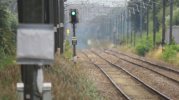Envoy
Established Member
- Joined
- 29 Aug 2014
- Messages
- 2,496
I have just been watching the Don Coffey You Tube video of Class 175 Chester to Manchester via Warrington. On leaving Chester, the line goes for miles virtually straight yet the speed limit is only 75 mph. Surely, with long welded rail trains such as the 175 should be allowed to do 100 mph? Faster trains would entice more people away from cars as well as cut staff costs and you would cover more miles per train but with higher energy costs.
The Newport to Cardiff 4 track line is also almost straight as it crosses the coastal plain. The two fast tracks (mains) have a speed limit of 95 mph whilst the two relief lines have a speed limit of only 60 mph. Why is this so as they are side by side crossing the same landscape, have the same signal gantries and long welded rail? The relief lines between Newport and Severn Tunnel Junction are even slower with a speed limit of only 40 mph although one of these crosses the Bishton flyover.
The Newport to Cardiff 4 track line is also almost straight as it crosses the coastal plain. The two fast tracks (mains) have a speed limit of 95 mph whilst the two relief lines have a speed limit of only 60 mph. Why is this so as they are side by side crossing the same landscape, have the same signal gantries and long welded rail? The relief lines between Newport and Severn Tunnel Junction are even slower with a speed limit of only 40 mph although one of these crosses the Bishton flyover.

